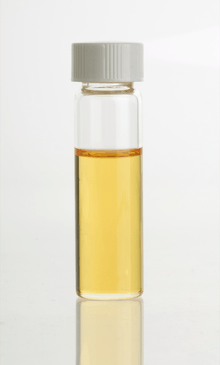Cedar oil
Cedar oil, also known as cedarwood oil, is an essential oil derived from various types of conifers, most in the pine or cypress botanical families. It is produced from the foliage, and sometimes the wood, roots, and stumps which have been left after cutting of trees for timber extraction. It has many uses in medicine, art, industry and perfumery, and while the characteristics of oils derived from various species may themselves vary, all have some degree of bactericidal and pesticidal effects.

Sources and characteristics
Although termed cedar or cedarwood oils, the most important oils are produced from distilling wood of a number of different junipers and cypresses (of the family Cupressaceae), rather than true cedars (of the family Pinaceae).[1] Similar oils are distilled, pressed or chemically extracted in small quantities from wood, roots, and leaves from plants of the genera Platycladus, Cupressus, Taiwania, and Calocedrus.
The cedarwood oil of the ancients, in particular the Sumerians and Egyptians, was derived from the Cedar of Lebanon, a true cedar native to the northern and western mountains of the Middle East. The once-mighty Cedar of Lebanon forests of antiquity have been almost entirely eradicated, and today no commercial oil extraction is based on this species. One of the elements found in many cedar trees is cedrol. Depending on the amount of cedrol in a specific species of cedar can determine its pesticidal effect on insects. Ancient Egyptians would use the oil from cedar trees in the embalming process, which in effect helped to keep the insects from disturbing the body.
Uses
Cedarwood oils each have characteristic woody odours which may change somewhat in the course of drying out. The crude oils are often yellowish or even darker in color and some, such as Texas cedarwood oil (derived primarily from Juniperus ashei and J. deppeana), are quite viscous and deposit crystals on standing. They find use (sometimes after rectification) in a range of fragrance applications such as soap perfumes, household sprays, floor polishes and insecticides. Small quantities are used in microscope work as a clearing oil.
All the cedarwood oils of commerce contain a group of chemically related compounds, the relative proportions of which depend upon the species from which the oil is obtained. These compounds include cedrol and cedrene, and while they contribute something to the odor of the whole oil they are also valuable to the chemical industry for conversion to other derivatives with fragrance applications. The oils are therefore used both directly and as sources of chemical isolates.
Cedarwood oil was used as the base for paints by the ancient Sumerians. They would grind cobalt compounds in a mortar to produce a blue pigment. They could obtain green from copper, yellow from lead antimonate, black from charcoal, and white from gypsum.
Today, cedarwood oil is often used for its aromatic properties, especially in aromatherapy; it can also be used to renew the smell of natural cedar furniture. Cedarwood oil is used as an insect repellent, both directly applied to the skin and as an additive to sprays, candles and other products.
In India, oil from the deodar cedar (Cedrus deodara, a true cedar) has been shown to possess insecticidal and antifungal properties and to have some potential for control of fungal deterioration of spices during storage.
One of three methods of ancient Egyptian embalming practices employs the use of cedarwood oil. This was a less costly method than the best known of the ancient Egyptian practices of removing internal organs for separate preservation in canopic jars. The practice
...called for the injection of cedar oil into body cavities without evisceration. The body was laid in natrum or natron—a fixed alkali—for the prescribed period, after which the cedarwood oil, which had dissolved the soft organs, was released; and the body, its flesh dissolved by the natron, was reduced to preserved skin and bones.[2]
Until the development of synthetic immersion oil in the 1940s, cedarwood oil was widely used for the oil immersion objective in light microscopy. It is still sometimes also used to clarify emeralds.[3]
Cedar leaf oil from Cedrus atlantica does not contain thujone.
Cedarwood oil is a mixture of organic compounds considered generally safe by the FDA as a food additive preservative. The oil is used as an antibacterial and fungicide. The United States EPA does not expect such effects to occur among users of currently registered products because their use and public exposure is at a much lower level and more intermittent than those in the case studies. The EPA believes there is negligible human environmental risk posed by exposure to registered cedarwood pesticide or food preservative products if used in properly prescribed manner.
Notes
- Chapter 10: Cedarwood Oils, United Nations Food and Agriculture Organization report
- Habenstein, Robert W.; Lamers, William M. (2007). The History of American Funeral Directing. Burton & Mayer, Inc.
- https://www.gemsociety.org/article/emerald-enhancement/